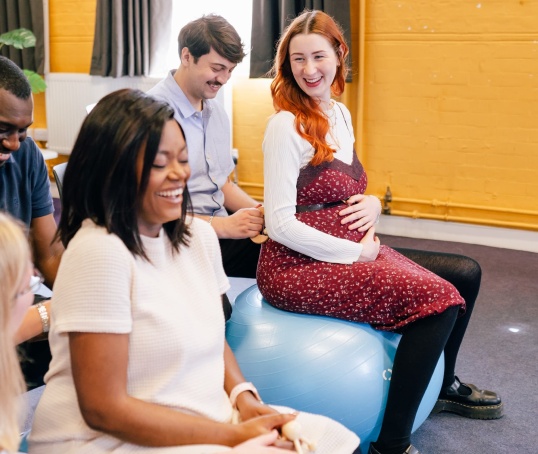From ‘Am I in labour?’ to ‘When to call the midwife?’ and ‘How do we know the baby is OK?’ to ‘What is transition?’ Read our guide to the first stage of labour.
Signs that labour might start in the next few days or weeks
When you notice these behaviours, make sure a hospital bag is ready.
Nesting
This is a common experience. It includes a burst of energy and preparing for the arrival of the baby by cleaning or organising the home (Hundley et al, 2020).
Social preferences
Along with nesting, the pregnant woman or person might prefer to remain close to home. They could choose to spend time with people who are familiar and close to them rather than people they don’t know so well (Hundley et al, 2020).
Having ‘a show’
The mucus plug might loosen and pass out of the vagina – this can also be called having a ‘show’.
Braxton Hicks contractions
Some people notice Braxton Hicks from early pregnancy. Others never become aware of them.
These are contractions of the uterus and can be uncomfortable. The belly goes hard and feels tight. These contractions are short, irregular, and stop happening after a while (NHS, 2023a).
Braxton Hicks are a good opportunity to practice any breathing or other coping strategies that could be used in labour.
How to recognise when labour starts
Unlike in TV shows and movies, labour doesn’t usually start with the waters breaking. Mostly, pregnant women and people just become aware of sensations which gradually become longer, stronger and more frequent (Hundley et al, 2020).
Get medical help urgently if (NHS, 2023a):
- There is an unexpected urge to push – don't go anywhere, call 999 and ask for an ambulance
- The waters break and they are not clear, if there is lots of bright blood, or they smell bad – call the maternity unit straight away to say you’re on your way to hospital.
What are the stages of labour?
To the pregnant woman or person, labour will usually feel like a continuous process that ends with the birth of the baby. They won’t necessarily recognise different parts to it (Dixon et al, 2013; Hundley et al, 2020).
However, doctors and midwives divide labour into three stages (NICE, 2023):
- First stage (labouring)
- Second stage (birthing the baby)
- Third stage (birth of the placenta)
The first stage of labour can be broken down further into latent, and active or established.
Latent first stage
This early part can last hours or days (NHS, 2023b). It might also happen while the pregnant woman or person is asleep and may not be noticed. Everyone experiences it differently, but it could include (Hundley et al, 2020; NHS, 2023a; NHS, 2023b):
- a change in sleep patterns
- nausea, vomiting, diahorrea
- noticing the mucus plug
- back pain
- contractions starting
At this point there is no clear pattern to contractions. They may be spaced out and not last long. They may be slightly uncomfortable, or more painful (NHS, 2023b).
It may take a while to decide if these are Braxton Hicks or labour contractions. It is still possible to hold a conversation during and between contractions at this point.
If the ’waters’ break
The baby is held within a sac containing amniotic fluid. The membranes of this sac usually rupture and release the fluid later during the second stage of labour. This is known as the ‘waters breaking’.
However, sometimes this happens before contractions start, and this is called pre-labour rupture of membranes (PROM) (NHS, 2023a). This is why it can be a good idea to sleep on a towel in late pregnancy.
Use a maternity pad if this happens, and call the midwife for guidance (NHS, 2023a). When the waters have been ruptured for 24 hours, induction will be offered.
Coping with the latent phase
The pregnant woman or person might want to distract themselves by (NHS, 2023b):
- Getting on with everyday activities
- Eating and drinking to maintain energy
- Staying upright, to help the baby move down
- Using calming techniques, e.g. breathing exercises
- Having a warm bath, shower or hot water bottle
- Going for a walk (preferably with someone)
- Checking their hospital bag is ready
- Preparing snacks for labour
- Sleeping if they can
- Using a TENS machine if contractions are uncomfortable
The father, co-parent or birth partner can support by (Bohren et al, 2017):
- asking what they need
- being with them, providing snacks and drinks
- providing comfort and support
- coping techniques
- encouraging them to move around
Read more about birth partner support in our article.
Should I go to hospital?
At this point of labour, medical support is not usually necessary. Staying at home for as long as possible can mean that there are fewer interventions in the labour (Hundley et al, 2020). This is why healthcare professionals will encourage the pregnant woman or person to remain at home if there is no need for medical attention (NICE, 2023).
Pregnant women and people might want to see or talk to a health professional to ‘confirm’ they are in labour. They may want reassurance, information or guidance (Müller & Grylka-Baeschlin, 2024). They may not feel comfortable or safe at home (SANDS, 2024).
But being sent home from hospital because labour isn’t established can feel disempowering (Hundley et al, 2020).
An early assessment by telephone or in-person can help women and birthing people feel more confident about coping with labour at home, and reduce later interventions (Kobayashi et al, 2017).
A recent small study showed that a video call with a midwife could provide this support (Nyman et al, 2024).
Some parents find a doula can provide this support and reassurance.
What pain relief might help in latent labour?
A common recommendation is to take paracetamol, as this has no impact on the baby so is considered safe (NHS, 2023a).
Paracetamol may be used in combination with other medication such as codeine for women sent home from hospital in early labour. This doesn’t affect the baby or the chance of measures to strengthen labour, the use of epidural, or the mode of birth. However, there is evidence that it can increase the duration of labour by around 10 hours (Bagger et al, 2023).
What are contractions and what do they feel like?
The uterus is a bag made of muscles, and contractions are those muscles working hard. The muscles contract, then rest, then contract again. Over time, the contractions get longer and stronger, and the gaps between them get shorter.
In the first stage of labour the contractions are shortening from the top of the uterus to the cervix, pulling the cervix open.
Everyone experiences contractions differently. In this video, some mothers and birthing parents describe what contractions felt like to them.
Early contractions can be described as:
- Like period pain that becomes more intense
- Backache or leg ache
Between contractions the uterus relaxes, and the woman or birthing person feels no pain (NHS, 2023a).
Active/established phase
There is no definition agreed by everyone of when the latent first stage moves into active or established labour (Hundley et al, 2017). As a rough guide (NHS, 2023b):
- Contractions become stronger, more regular and closer together
- If someone hasn’t noticed the latent stage, they might suddenly notice strong contractions
- It won’t be possible to talk during a contraction. The labouring person will need to focus
- Between contractions, talking will be possible at first. As contractions get closer together the labouring person will want to use the time between them to rest.
As contractions get stronger:
- Focus on coping strategies during the contraction, for example using self-help or hypnobirthing techniques
- Rest between contractions to conserve energy
- You might want to time contractions when you think they might be more than 1 in 10 minutes
- A shower, bath, or birth pool can help
At some point, the pregnant woman or person might start switching off from the world around them as they focus on their labour.
When to call the midwife?
- Some people may have been told to call at a specific time, perhaps due to their medical situation or having twins.
- Call the labour line at any time for support or reassurance, or if you’re unsure what to do (NHS, 2023a). The birth partner needs to have this number available.
- When you call, the midwife will want to speak to the labouring woman or person to assess them over the phone. They will be looking for signs of established labour (NICE, 2023).
- General guidance is to seek midwifery support when two contractions are being felt within 10 minutes (NHS, 2023a).
- BUT if you feel it’s important to see a health professional, then don’t wait.
- If using self-help techniques like hypnobirthing, let the midwife know so they’re aware the labouring woman or person may appear calmer than expected.
- The midwife will provide guidance on when to move to a hospital or birth centre if that is the plan. If planning a home birth they can arrange for the midwife to come out.
Also let the midwife know if:
- There is a specific need for language support
- There is a need for specific support for additional needs or protected characteristics
Sometimes things progress more quickly than expected.
- If at any point the woman or birthing parent feels an urgent need to see a health professional, then follow that instinct.
- If you notice an urge to push, or the woman or birthing person making sounds like they might be pushing, then call for urgent assistance. Do not start travelling.
Call hospital or the maternity unit urgently if (NHS, 2023a):
- There is vaginal bleeding
- The baby is moving less than usual
- You’re less than 37 weeks pregnant and you think you may be in labour
- Contractions are lasting longer than two minutes
- There are more than six contractions in 10 minutes
What support is helpful in active labour?
Go to our article on how the father, birth partner or co-parent can support the pregnant woman or person.
What positions are best for active labour?
Walking and upright positions can reduce how long labour lasts, as well as the need for pain relief or a caesarean birth (Lawrence et al, 2013).
What pain relief can be used in active labour?
All forms of pain relief can be used in active labour, depending on the location and availability. See our articles on pain relief.
How long does active labour last?
When labour is confirmed by health professionals as established, the first stage will continue for on average 8 hours for a first-time parent. It’s unlikely to last longer than 18 hours (NICE, 2023).
For someone who has previously given birth vaginally, the average is 5 hours, and unlikely to last longer than 12 hours (NICE, 2023).
How do we know everyone is well?
Throughout established labour, a midwife will be monitoring the pregnant woman or person and the baby at regular intervals. If there are any concerns, or if labour slows or stops, health professionals will discuss with you what can be done (NICE, 2023).
This might mean some more frequent or different monitoring, or a move to augmentation of labour. In some circumstances, it may be recommended to move to caesarean birth (NICE, 2023).
All decisions are made by the pregnant woman or person, with input from health professionals and the father, co-parent or birth partner (NICE, 2023).
The midwife should be someone the woman or birthing parent can trust. They should provide information and guidance, so the woman or birthing person can make an informed decision (NICE, 2023).
If there is a lack of confidence in the healthcare professional, it is encouraged to ask for a second opinion or a different caregiver (The Patients Association, no date).
Transition
This is the last part of the first stage of labour, before birthing the baby.
At this point, everything can get more intense because:
- The woman or birthing person may be tired after labouring for several hours.
- The hormones adrenaline and noradrenaline are released to give a surge of energy to birth the baby.
The woman or birthing person might (Gutteridge, 2013):
- Appear in a trance as they focus on coping with the intense sensations in their body
- Seem agitated and uncomfortable
- Feel shivery – covering shoulders and using socks can help
- Feel nauseous or be sick
- Be weepy and express feeling overwhelmed or defeated
- Ask for additional pain relief. However, at this point it is probably too late to set up an epidural.
The birth partner may find this behaviour unsettling if they aren’t expecting it. It can help to remember that this means the baby is almost here.
Transition moves the labour into the next phase, the second stage of labour when the baby will be born.
Bohren MA, Hofmeyr GJ, Sakala C, Fukuzawa RK, Cuthbert A. (2017) Continuous support for women during childbirth. Cochrane Database of Systematic Reviews, Issue 7. Art. No.: CD003766. https://doi.org/10.1002/14651858.CD003766.pub6
Dixon L, Skinner J, Foureur M. (2013) Women's perspectives of the stages and phases of labour. Midwifery. 29(1):10-7. https://doi.org/10.1016/j.midw.2012.07.001
Gutteridge K. (2013) Assessing progress through labour using midwifery wisdom. Essentially MIDIRS 4(3):17-22. https://www.researchgate.net/publication/261365284_Assessing_progress_t… [27 Jan 25]
Hundley V, Downe S, Buckley SJ (2020) The initiation of labour at term gestation: Physiology and practice implications, Best Practice & Research Clinical Obstetrics & Gynaecology, 67,Pages 4-18. https://doi.org/10.1016/j.bpobgyn.2020.02.006
Kobayashi S, Hanada N, Matsuzaki M, Takehara K, Ota E, Sasaki H, Nagata C, Mori R. (2017) Assessment and support during early labour for improving birth outcomes. Cochrane Database of Systematic Reviews, Issue 4. Art. No.: CD011516. https://doi.org/10.1002/14651858.CD011516.pub2
Lawrence A, Lewis L, Hofmeyr GJ, Styles C. (2013) Maternal positions and mobility during first stage labour. Cochrane Database of Systematic Reviews, Issue 10. Art. No.: CD003934. https://doi.org/10.1002/14651858.CD003934.pub4
Müller, A ; Grylka-Baeschlin, S (2024) Pregnant Women's Care Needs During Early Labor–A Scoping Review. Birth. 0:1-21. https://doi.org/10.1111/birt.12891
NHS (2023b) The stages of labour and birth. https://www.nhs.uk/pregnancy/labour-and-birth/what-happens/the-stages-o… [5 Feb 25]
NHS. (2023a) Signs that labour has begun. https://www.nhs.uk/pregnancy/labour-and-birth/signs-of-labour/signs-tha… [21 Jan 25]
NICE. (2023) Intrapartum care [NG235]. https://www.nice.org.uk/guidance/ng235 [21 Jan 25]
SANDS (2024) When to contact maternity services? Sands and Tommy's Joint Policy Unit finds too much variation in advice. https://www.sands.org.uk/about-sands/media-centre/news/2024/08/when-con… [27 Jan 25]
The Patients Association (No date) Getting a second opinion. https://www.patients-association.org.uk/getting-a-second-opinion [14 Nov 24]







